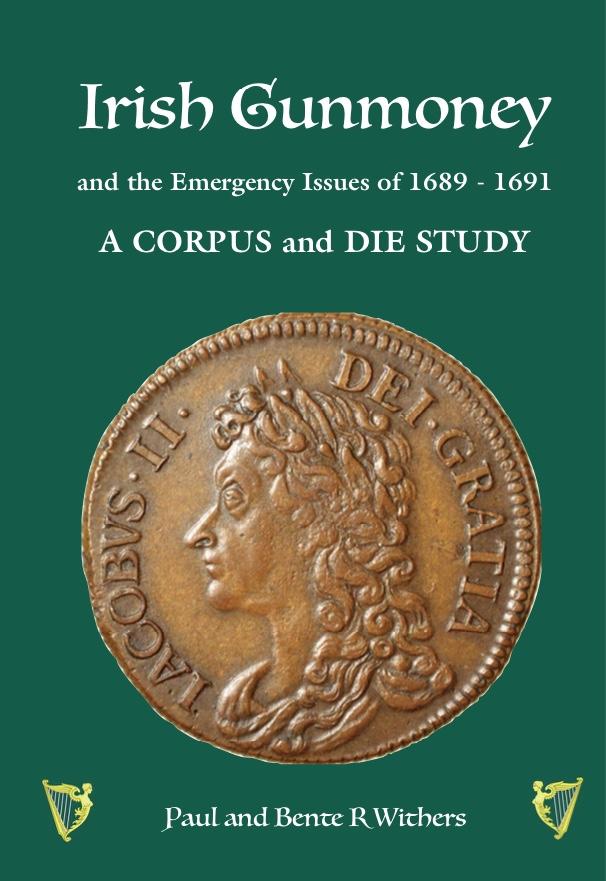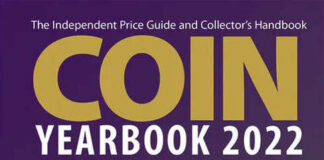
Readers in Europe unfamiliar with Irish gunmoney may not know that it is a highly unusual high face value token coinage of base metal issued by the deposed Catholic king James II of England who fled to France and then went to Ireland supported by Louis XIV’s money and a French army to try to regain his kingdom with the support of the southern Irish Roman Catholic population. The coins were of a promissory nature and are even more remarkable in that they carry a month date as well as the year of issue. There is quite a lot known about the coins, and they should be better known in Europe as fighting on the side of Protestant William III (of Orange) were a large number of Dutch soldiers as well as mercenaries from Denmark and Prussia and protestants from Northern Ireland and Scotland. Effectively it was a pan-European conflict.
About the Book
Paul and Bente R Withers are the main authors of this new work on Irish gunmoney. They had considerable help, encouragement and co-operation from John Rainey, David Greenhalgh, and Gary Oddie who has written a chapter on ‘Estimating the number of dies used to strike the Gunmoney coinage’.
The authors look closely at the brass gunmoney, pewter money, and the Hibernia coins of Limerick at a die and individual punch level. It begins with explanatory chapters on the historical background, mint practices, die making and production errors. How to use the book. How to tell the difference between the products of the Dublin and Limerick mints and another mint that was striking gunmoney, probably also located in Dublin. How the coins were made. How the dies were made. Wartime Propaganda. The story of the 1690 and 1691 sieges of Limerick. The Protestant north, and after the war. Restrikes, forgeries, and fakes, contemporary and modern are also covered. Over 2,000 different die varieties are described and illustrated, all life size, or larger. All die links are noted, including cross-month mules.
The Result of a Far-Reaching Research Project
The book has been twelve years in research, development and preparation and been written by a husband and wife prize-winning (AIPN, RNS and BNS) team of numismatic authors, one of whom was an educationalist by training, who, to get exactly what they want, have done the design, specialist typesetting and much of the photography themselves to replicate, as far as possible, the relative sizes and shapes and fonts of the letters used within the text of the book. John Rainey himself has the largest and best collection gunmoney in private hands, but the authors have also been helped by several other private collectors with significant collections, including those in the USA, Europe, the UK, and of course, northern Ireland and Eire. During their research, they have also had access to the major museum collections in Ireland, north and south, and the UK, and received help for over a decade from their curators.
Practical Help for Collectors
The book also covers the emergency coinage of ‘Hibernia’ halfpennies produced in Limerick after the Jacobites had been defeated, and the pewter halfpennies, pennies, the pattern groat and crown; the London restrikes, later copies and forgeries. Expert type-setting and enlargements show how and where to look for varieties that you might otherwise miss. There is a general index as well as indexes of obverse and reverse legends.
So that collectors may know how rare, or common their coins are, the book reveals how many coins of each die combination they have seen.
A previous book on gunmoney was general in nature and full of errors, both of omission and commission, but the authors of this one are confident that apart from new varieties that may turn up, they have covered the field adequately. It also leaves the area open to further work by students, archaeologists and economists who wish to pursue their own line of study. This book sets new numismatic standards both as to quality of and quantity of information delivered to readers.
European collectors can order their copy at Galata, US customers from Del Parker.
For an introduction to the gunmoney of James II, continue reading here.




